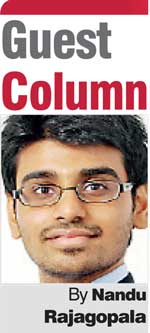Thursday Nov 27, 2025
Thursday Nov 27, 2025
Thursday, 16 February 2017 00:00 - - {{hitsCtrl.values.hits}}
One evening, around dusk, I found myself being driven through a slum-type area in Pamankada. With Havelock Road now one-way for the most part, Veluwanarama Road, where this neighbourhood was located, has seen a somewhat modest surge in traffic as it allows one to get into the suburbs more quickly. 
Although the sickly-sweet faecal smell from the canal nearby made me acutely aware of the less-than-desirable area that I was in, I call it slum-type and not an outright slum as it did not seem as destitute as those found in other parts of South Asia.
At any rate, to put it in context for the more privileged of us, the poverty in question was not as abject as that depicted in some Hollywood productions. No muddied children begging on the road, no signs of gross malnutrition, no homeless loitering about. In fact, the occasional glint of a satellite dish on some rooftops provided a reason to be optimistic.
Although areas of this sort are not unusual in developing countries like Sri Lanka, I was quite surprised to stumble across this settlement in what I thought was an affluent part of Colombo. For those who have not found themselves on this route, the hamlet makes for an interesting study.
Located between a busy road and the Dehiwala canal, it consists of a Buddhist temple, a couple of village-style grocery stores and a row of shanties hugging the road. These housing structures, with walls fortified with cheap plywood at various places, were only about a couple of square metres in size – hardly adequate to accommodate the scores of people that seemed to spill out from each. With their low roofs, matchbox-like compactness and a general lack of ventilation, they looked more like burrows dug out by nocturnal animals than dwelling fit for humans.
Since the road was not more than 20 feet wide, peering out of the tuk-tuk that I was in afforded unobstructed views into several of these houses. Not only was the size of the road conducive to a sneak peek but the only barrier between most front doors and the road was a shallow ditch and, in some cases, it was just a faded, frayed curtain that stood in for a front door.
Inside, the space available had been skilfully used to get the biggest bang for the buck; depending on which corner you focused on, you could either be looking at a bedroom, kitchen, study or anything in between. And, as far as I could make out in the dim fluorescent lights, the contents inside pointed to life at its very basic: ’80s style TVs, plastic furniture (in fact, most things I saw seemed to be made out of plastic), a bed and walls with peeling paint.
As much as the neighbourhood screamed ‘have-nots!’ to an average Joe passing by, observing the people milling around made me stop and wonder. There was a peculiar and palpable sense of contentment: the city’s typical humdrum seemed a world away; the people, although at the lower end of Colombo’s socio-economic class, a lot more at ease with life; and, amidst all the street cricket and the clang of roti chopping blades, there existed a very real sense of community.
Do the folks here not have the same desires and life pressures as the rest of us? Here they were, poor but strangely satisfied with life while the rest of Colombo was enveloped in a rush-hour marking the end of yet another wealth accumulation drill.
In a world that, unfortunately, places too much emphasis on outward appearances and material possession, the relationship between wealth and personal happiness seems increasingly blown out of proportion. Just like trying to swat a fly, the vast majority of us keep chasing this elusive concept of happiness by amassing money and just when we think it is within reach, we discover that we probably need to work a little bit harder. And on and on the cycle goes. I am not trying to carve out an argument against capitalism nor am I trying to romanticise poverty, but something is obviously amiss in the way humanity looks at life.
Whatever happiness is, at the end of the day, it all boils down to this: you don’t need much money to watch in awe as nature paints the sky pink, purple and gold at dawn or to enjoy a good book over a good cup of coffee. Perhaps this realisation is the source of Veluwanarama Road’s take on life and what the rest of us, climbing the greasy pole of life, should probably pay more attention to.